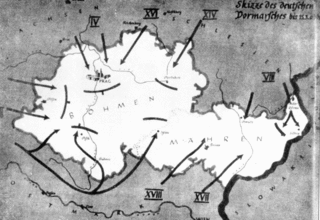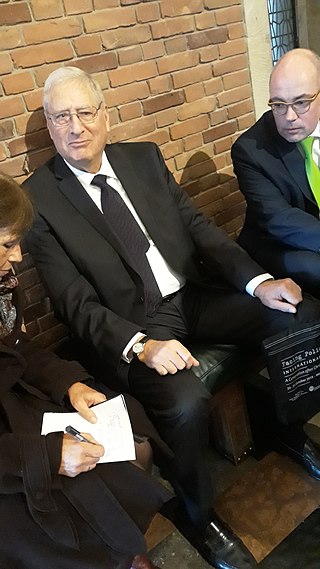
The Final Solution or the Final Solution to the Jewish Question was a Nazi plan for the genocide of individuals they defined as Jews during World War II. The "Final Solution to the Jewish question" was the official code name for the murder of all Jews within reach, which was not restricted to the European continent. This policy of deliberate and systematic genocide starting across German-occupied Europe was formulated in procedural and geopolitical terms by Nazi leadership in January 1942 at the Wannsee Conference held near Berlin, and culminated in the Holocaust, which saw the murder of 90% of Polish Jews, and two-thirds of the Jewish population of Europe.

The Wannsee Conference was a meeting of senior government officials of Nazi Germany and Schutzstaffel (SS) leaders, held in the Berlin suburb of Wannsee on 20 January 1942. The purpose of the conference, called by the director of the Reich Security Main Office SS-Obergruppenführer Reinhard Heydrich, was to ensure the co-operation of administrative leaders of various government departments in the implementation of the Final Solution to the Jewish Question, whereby most of the Jews of German-occupied Europe would be deported to occupied Poland and murdered. Conference participants included representatives from several government ministries, including state secretaries from the Foreign Office, the justice, interior, and state ministries, and representatives from the SS. In the course of the meeting, Heydrich outlined how European Jews would be rounded up and sent to extermination camps in the General Government, where they would be killed.

The Sudetenland is historical German name for the northern, southern, and western areas of former Czechoslovakia which were inhabited primarily by Sudeten Germans. These German speakers had predominated in the border districts of Bohemia, Moravia, and Czech Silesia since the Middle Ages. Sudetenland had been since the 9th century an integral part of the Czech state both geographically and politically.

During the later stages of World War II and the post-war period, Germans and Volksdeutsche fled and were expelled from various Eastern and Central European countries, including Czechoslovakia and the former German provinces of Silesia, Pomerania, and East Prussia, which were annexed by Poland and the Soviet Union. The idea to expel the Germans from the annexed territories was proposed by Winston Churchill, in conjunction with the Polish and Czechoslovak exile governments in London at least since 1942. In late 1944 the Czechoslovak exile government pressed the Allies to espouse the principle of German population transfers. On the other hand, Polish prime minister Tomasz Arciszewski, in an interview for The Sunday Times on 17 December 1944, supported the annexation of Warmia-Masuria, Opole Regency, north-east parts of Lower Silesia, and parts of Pomerania, but he opposed the idea of expulsion. He wanted to naturalize the Germans as Polish citizens and to assimilate them.

In Nazi German terminology, Volksdeutsche were "people whose language and culture had German origins but who did not hold German citizenship". The term is the nominalised plural of volksdeutsch, with Volksdeutsche denoting a singular female, and Volksdeutsche(r), a singular male. The words Volk and völkisch conveyed the meanings of "folk".

Terezín is a town in Litoměřice District in the Ústí nad Labem Region of the Czech Republic. It has about 2,800 inhabitants. It is a former military fortress composed of the citadel and adjacent walled garrison town. The town centre is well preserved and is protected by law as an urban monument reservation. Terezin is most infamously the location of the Nazis' notorious Theresienstadt Ghetto.

The Generalplan Ost, abbreviated GPO, was the Nazi German government's plan for the genocide and ethnic cleansing on a vast scale, and colonization of Central and Eastern Europe by Germans. It was to be undertaken in territories occupied by Germany during World War II. The plan was attempted during the war, resulting indirectly and directly in the deaths of millions by shootings, starvation, disease, extermination through labor, and genocide. However, its full implementation was not considered practicable during major military operations, and never materialized due to Germany's defeat.

The military occupation of Czechoslovakia by Nazi Germany began with the German annexation of the Sudetenland in 1938, continued with the creation of the Protectorate of Bohemia and Moravia, and by the end of 1944 extended to all parts of Czechoslovakia.
This is a list of words, terms, concepts and slogans of Nazi Germany used in the historiography covering the Nazi regime. Some words were coined by Adolf Hitler and other Nazi Party members. Other words and concepts were borrowed and appropriated, and other terms were already in use during the Weimar Republic. Finally, some are taken from Germany's cultural tradition.

The Madagascar Plan was a plan to forcibly relocate the Jewish population of Europe to the island of Madagascar which was proposed by the Nazi German government. Franz Rademacher, head of the Jewish Department of the German Foreign Office, proposed the idea in June 1940, shortly before the Fall of France. The proposal called for the handing over of control of Madagascar, then a French colony, to Germany as part of the eventual peace terms.

Christopher Robert Browning is an American historian who is the professor emeritus of history at the University of North Carolina at Chapel Hill (UNC). A specialist on the Holocaust, Browning is known for his work documenting the Final Solution, the behavior of those implementing Nazi policies, and the use of survivor testimony. He is the author of nine books, including Ordinary Men (1992) and The Origins of the Final Solution (2004).

German Bohemians, later known as Sudeten Germans, were ethnic Germans living in the Czech lands of the Bohemian Crown, which later became an integral part of Czechoslovakia. Before 1945, over three million German Bohemians constituted about 23% of the population of the whole country and about 29.5% of the population of Bohemia and Moravia. Ethnic Germans migrated into the Kingdom of Bohemia, an electoral territory of the Holy Roman Empire, from the 11th century, mostly in the border regions of what was later called the "Sudetenland", which was named after the Sudeten Mountains.

The functionalism–intentionalism debate is a historiographical debate about the origins of the Holocaust as well as most aspects of the Third Reich, such as foreign policy. The debate on the origins of the Holocaust centres on essentially two questions:
The Jewish question, also referred to as the Jewish problem, was a wide-ranging debate in 19th- and 20th-century European society that pertained to the appropriate status and treatment of Jews. The debate, which was similar to other "national questions", dealt with the civil, legal, national, and political status of Jews as a minority within society, particularly in Europe during the 18th, 19th, and 20th centuries.
Names of the Holocaust vary based on context. "The Holocaust" is the name commonly applied in English since the mid-1940s to the systematic extermination of 6 million Jews by Nazi Germany during World War II. The term is also used more broadly to include the Nazi Party's systematic murder of millions of people in other groups they determined were "untermensch" or "subhuman," which included primarily the Jews and the Slavs, the former having allegedly infected the latter, including ethnic Poles, the Serbs, Russians, the Czechs and others.

Untermensch is a Nazi term for non-Aryan people they deem as inferior, who were often referred to as "the masses from the East", that is Jews, Roma, and Slavs. The term was also applied to mixed race and black people. Jewish, Polish and Romani people, along with the physically and mentally disabled, as well as homosexuals and political dissidents, and on rare instances, POWs from Western Allied armies, were to be exterminated in the Holocaust. According to the Generalplan Ost, the Slavic population of East-Central Europe was to be reduced in part through mass murder in the Holocaust, with a majority expelled to Asia and used as slave labor in the Reich. These concepts were an important part of the Nazi racial policy.

The Posen speeches were two speeches made by Heinrich Himmler, the head of the SS of Nazi Germany, on 4 and 6 October 1943 in the town hall of Posen (Poznań), in German-occupied Poland. The recordings are the first known documents in which a member of the Hitler Cabinet spoke of the ongoing extermination of the Jews in extermination camps. They demonstrate that the German government wanted, planned and carried out the Holocaust.

The expulsion of Germans from Czechoslovakia after World War II was part of a series of evacuations and deportations of Germans from Central and Eastern Europe during and after World War II.

The Nisko Plan was an operation to deport Jews to the Lublin District of the General Governorate of occupied Poland in 1939. Organized by Nazi Germany, the plan was cancelled in early 1940.

The Czechoslovak government-in-exile, sometimes styled officially as the Provisional Government of Czechoslovakia, was an informal title conferred upon the Czechoslovak National Liberation Committee, initially by British diplomatic recognition. The name came to be used by other Allied governments during the Second World War as they subsequently recognised it. The committee was originally created by the former Czechoslovak President, Edvard Beneš in Paris, France, in October 1939. Unsuccessful negotiations with France for diplomatic status, as well as the impending Nazi occupation of France, forced the committee to withdraw to London in 1940. The Czechoslovak Government-in-Exile offices were at various locations in London but mainly at a building called Fursecroft.














